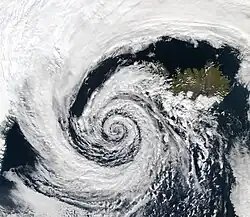An Icelandic cyclone on September 4, 2003 The Icelandic Low is a semi-permanent centre of low atmospheric pressure found between Iceland and southern Greenland and extending in the Northern Hemisphere winter into the Barents Sea. In the summer, it weakens and splits into two centres, one near Davis Strait, Labrador, and the other west of Iceland. It is a principal centre of action in the atmosphere circulation of the Northern Hemisphere, associated with frequent cyclone activity. It forms one pole of the North Atlantic oscillation , the other being the Azores High .
References
Cyclones and anticyclones of the world (centers of action)
Concepts
Anticyclonic storm
Storm
High-pressure area
Low-pressure area
Rapid intensification
Explosive cyclogenesis
Central dense overcast
Annular tropical cyclone
Bar (tropical cyclone)
Superstorm
Hypercane
Tropical cyclones and climate change Post-tropical cyclone
Sting jet
Rainband Anticyclone
Northern Hemisphere
North Polar High
Siberian High
Azores High North American High
North Pacific High
Ridiculously Resilient Ridge
Subtropical ridge Southern Hemisphere
Cyclone
Synoptic scale
Surface-based
Polar
North Polar low
South Polar low
Great Arctic Cyclone of 2012 Extratropical
North America
Continental
Lee Cyclone
Alberta clipper Colorado low Great Basin low Bighorn Low Other
Panhandle hook November gale
Oceanic
Aleutian Low
Hatteras low
Nor'easter
Gulf low
Pacific Northwest windstorm
Europe Asia
Asiatic Low
Western Disturbance
Continental North Asian storms
East Asian-northwest Pacific storms Southern Hemisphere
Southern Ocean cyclone
Sudestada
Subtropical
Kona storm
Australian east coast low
Black nor'easter
Lake Huron cyclone
Mediterranean tropical-like cyclone
Thermal Tropical
Northern Hemisphere
Atlantic hurricane
Pacific hurricane Typhoon
North Indian Ocean tropical cyclone Mediterranean tropical-like cyclone Black Sea tropical-like cyclone Southern Hemisphere
South-West Indian Ocean tropical cyclone Australian region tropical cyclone South Pacific tropical cyclone South Atlantic tropical cyclone
Upper level
Cold-core low
Cut-off low
Polar vortex
Upper tropospheric cyclonic vortex
Mesoscale
Mesoscale ocean eddies
Catalina eddy
Haida Eddies Mesoscale convective system
Wake Low
Mesohigh
Mesoscale convective vortex
Whirlwind
Major
Mesocyclone
Supercell
Low-topped supercell
Wall cloud
Funnel cloud
Tornado
Multiple-vortex tornado
Satellite tornado
Anticyclonic tornado
Landspout
Waterspout Minor
Gustnado
Dust devil
Steam devil
Fire whirl
portal portal
